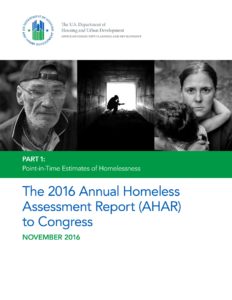By Jeremy Reynalds, Ph.D.
Founder and CEO
Joy Junction Inc.
 Maybe the bureaucrats at the U.S. Department of Housing and Urban Development (HUD) are the only ones who really believe the agency’s report that homelessness is on the decline.
Maybe the bureaucrats at the U.S. Department of Housing and Urban Development (HUD) are the only ones who really believe the agency’s report that homelessness is on the decline.
According to HUD’s latest national estimate, homelessness continues to decrease in the U.S, specifically among families with children, veterans, and individuals with long-term disabling conditions.
Bringing it home, HUD’s 2016 Annual Homeless Assessment Report to Congress found the number of persons experiencing homelessness in New Mexico on a single night in 2016 fell by 13.9 percent compared to 2015. There are reportedly 2,263 homeless people in New Mexico.
This caps an overall 34.9 percent decline in the state since 2010.
Specifically, from 2015, HUD estimates New Mexico experienced a 26.5 percent reduction among homeless families, a 61 percent decrease in veteran homelessness, and a 9.3 percent decline in individuals experiencing chronic homelessness.
We’ve got a lot of things to be thankful for this Thanksgiving week, but this report isn’t one of them. Why? Well, along with many others I don’t buy HUD’s rosy figures , which say there are about 1,300 homeless people in Albuquerque.
HUD has a deceptive and less than immediately transparent way of measuring who’s homeless. While the bureaucratic agency’s narrow homeless demographic has decreased, HUD doesn’t include homeless people who are couch surfing or those individuals or families living in often squalid motels usually on a day to day basis.
Its methodology is also troubling. Survey results are drawn from what is called the Point-in-Time (PIT) count, a survey of sheltered and unsheltered homeless persons on a single night in January. How many people were missed (unintentionally) here and nationwide, when volunteers went looking in places where the homeless are known to often hang out?
In addition to homeless “hot spots,” volunteers also counted individuals and families living in transitional housing and emergency shelters such as Joy Junction.
Why am I so concerned? In part, because while some media broadcasting results of the findings do point out HUD’s narrow definition of what it considers a homeless person (and concerns by homeless advocates), others don’t.
Consequently, some media consumers are left with the erroneous idea that we are making huge strides in our efforts to combat homelessness. Share that long enough, and city residents will internalize it, and feel there’s no need to get involved.
In an interview with the Albuquerque Journal, APS spokeswoman Monica Armenta said that the number of homeless kids enrolled in APS in the last five years has ranged from 4,000 to 6,500, depending on changing definitions of who is homeless and how to count them.
Comparing those numbers with HUD’s report leads me to think that something is rotten in Denmark.
I asked people on our Facebook page whether they believed homelessness is on the decline. Not surprisingly, none of the respondents believed it is.
There had been some hope on the horizon with the Homeless Children and Youth Act, or HCYA, which was introduced in both houses of Congress. However, the bill appears to have stalled in committee.
Backers say it would force HUD to align its definition with those used by federal programs for low-income families and vulnerable minors and reduce the requirements for proving homelessness.
Interestingly, the National Alliance to End Homelessness (NAEH) is opposed to the bill, saying in a June 2015 blog post shared from another organization that “There are NO new resources attached to the bill, and the nation is already short a couple hundred million to effectively serve existing unsheltered families and unaccompanied children and youth.”
Apparently the NAEH wants to keep the current and totally inadequate definition of homelessness, because while changing it would “increase” the number of homeless, there would be no more resources available to assist all of those newly “discovered” homeless individuals.
That is the most ridiculous thing I have ever heard. A change would allow us to have a better understanding of how many homeless people there really are, and strip away those glowing pronouncements from HUD about how well we are doing in the fight to “end” homelessness. Having gotten a real understanding of the situation, couldn’t we then marshal resources to better meet the need?
Apparently not for these folk, who like HUD officials, appear to be thinking and operating in some sort of alternate reality or parallel universe.
So when you’re asked to believe that statistics show the rate of homelessness is decreasing, take a look at who’s telling the story. As news commentator Paul Harvey used to say, you need “the rest of the story.”
And that story, as you can see, is far from being as positive as HUD – for whatever reason-would like you to think.



